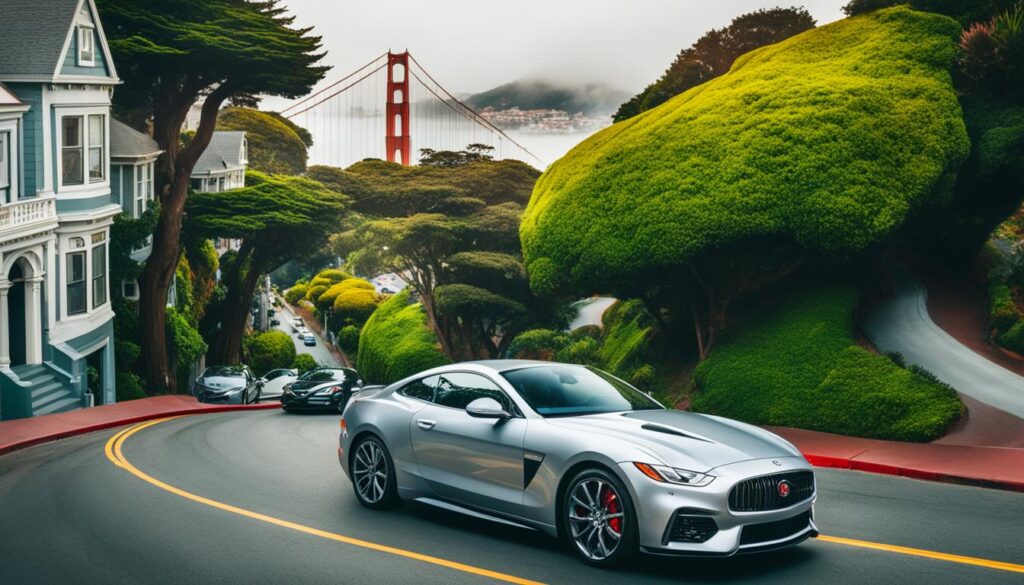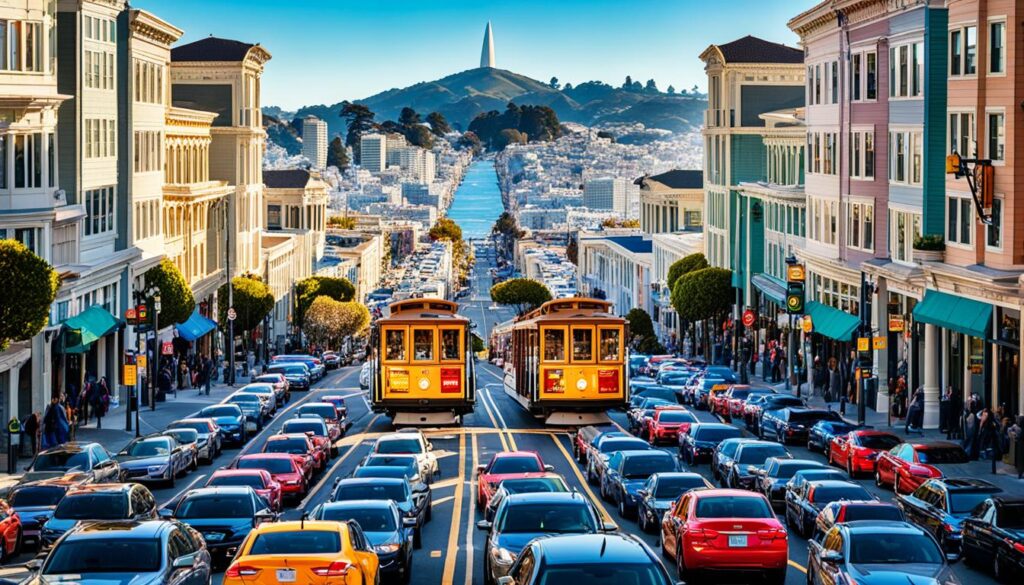Are you planning a trip to San Francisco and wondering how to navigate the city efficiently? Or perhaps you’re a local commuter exploring the best transportation options for your daily commute. The question is, should you rely on public transportation or rent a car in San Francisco?
Before you make a decision, let’s delve into the advantages and disadvantages of each option. From cost-effectiveness to convenience, we’ll compare public transportation and car rentals in San Francisco to help you find the best way to get around the city.
Whether you’re looking to explore iconic landmarks, visit neighboring regions, or commute to work, understanding the pros and cons is key. Stay with us as we guide you through the San Francisco transportation options, discuss the benefits of public transportation, and explore the convenience of renting a car in the Bay Area. Are you ready for the ultimate transportation comparison in San Francisco? Let’s get started!
Exploring San Francisco Public Transportation
When it comes to getting around the vibrant city of San Francisco, public transportation offers a convenient and eco-friendly solution. With a diverse range of options, including buses, streetcars, cable cars, and the iconic BART system, navigating the city is both accessible and efficient.
Advantages of Public Transportation
Choosing public transportation in San Francisco comes with several benefits. First and foremost, it allows you to avoid the hassle of finding parking, which can be a real challenge in busy areas. Whether you’re heading to popular tourist destinations or exploring local neighborhoods, you can easily hop on a bus or streetcar without worrying about where to leave your car.
Additionally, public transportation offers a cost-effective way to travel around the city. Fare prices are affordable, especially when compared to the expenses associated with renting a car and paying for parking. By utilizing public transportation, you can save money and allocate those funds towards more exciting experiences during your stay in San Francisco.
Moreover, using public transportation is an eco-friendly choice. With fewer cars on the road, public transportation reduces traffic congestion and helps reduce harmful emissions, contributing to a greener environment. By opting for public transportation, you’re making a positive impact on the city’s sustainability efforts.
Overview of San Francisco Public Transportation
San Francisco’s public transportation system encompasses a variety of modes to suit different travel needs. Here are some popular options:
- Buses: The extensive bus network covers all corners of the city, allowing you to reach even the most remote areas.
- Streetcars: San Francisco’s iconic cable cars and vintage streetcars offer a unique way to explore the city’s historic districts.
- BART: The Bay Area Rapid Transit system provides rapid transportation throughout the San Francisco Bay Area, connecting major cities and airports.
Each transportation mode has its own schedules and routes. To ensure a smooth journey, it’s advisable to plan your trips in advance and familiarize yourself with the schedules and routes relevant to your destinations.
Navigating San Francisco Public Transportation
To navigate San Francisco’s public transportation system effectively, it’s essential to familiarize yourself with the various tools available. One helpful resource is the “SFMTA” mobile app, which provides real-time information on bus and streetcar schedules and routes. Additionally, the official “BART” website offers detailed information and route maps for the Bay Area Rapid Transit system.
To pay for public transportation, you can conveniently use a reloadable Clipper Card, which allows for seamless transfers between different modes of transit. Clipper Cards can be purchased and reloaded at various locations throughout the city, including Walgreens stores and select BART stations.
San Francisco’s public transportation system is well-connected and covers most areas of the city. Utilizing these options can help you navigate San Francisco efficiently, regardless of whether you’re a visitor exploring the metropolis or a local resident commuting to work.
Now that we’ve explored the advantages of using public transportation in San Francisco and provided an overview of the different modes available, let’s delve into the benefits of renting a car in the next section.
Renting a Car in San Francisco
When it comes to exploring San Francisco, renting a car can offer you numerous benefits and added convenience. Whether you’re a visitor or a local looking to navigate the city at your own pace, renting a car provides the flexibility to tailor your transportation experience to your specific needs.
One of the primary advantages of renting a car is the freedom to explore beyond the city limits. San Francisco is surrounded by breathtaking natural landscapes, such as the scenic coastal drives along Highway 1 or the famous vineyards of Napa Valley. Renting a car allows you to journey beyond the city and truly experience the beauty of the Bay Area.
Benefits of Renting a Car in San Francisco:
- Flexibility to visit attractions outside of San Francisco
- Convenience of traveling on your schedule
- Accessibility to areas with limited public transportation
- Ability to store belongings securely
- Comfort and privacy during your travel
When it comes to selecting a car rental service in San Francisco, you have several options to choose from. Major car rental companies like Hertz, Avis, and Enterprise offer a wide range of vehicles to suit different budgets and preferences. Additionally, there are smaller, local car rental agencies that provide personalized service and competitive rates.
One key consideration when deciding between renting a car or using public transportation is cost. While renting a car may involve additional expenses such as fuel, parking fees, and insurance, it can still be a cost-effective option depending on your specific travel needs and group size. Comparing the overall expenses of renting a car versus using public transportation will help you make an informed decision.
Comparison of Renting a Car vs. Using Public Transportation in San Francisco
| Factors | Renting a Car | Using Public Transportation |
|---|---|---|
| Flexibility | Offers maximum flexibility in terms of travel destinations and schedules | Dependent on fixed routes and schedules |
| Convenience | Allows easy access to areas with limited public transportation options | May require transfers and longer travel times |
| Cost | Includes expenses such as fuel, parking fees, and insurance | Typically cheaper for shorter journeys and solo travelers |
| Accessibility | Provides accessibility for individuals with mobility restrictions | May have limited accessibility for certain areas or attractions |
Ultimately, the decision between renting a car and using public transportation in San Francisco boils down to your personal preferences, travel plans, and budget. Consider the benefits of renting a car, such as the freedom to explore beyond the city and travel on your own schedule. Evaluate the available car rental services in San Francisco and compare them to the convenience and cost-efficiency of public transportation. By weighing these factors, you’ll be able to make an informed choice and enjoy your time in San Francisco to the fullest.
Pros and Cons of Public Transportation
Public transportation in San Francisco offers numerous advantages that make it a popular choice for both visitors and locals. Let’s explore the benefits of using public transportation and the potential drawbacks you should consider:
Advantages of Public Transportation in San Francisco
- Cost-effectiveness: Using public transportation in San Francisco is generally more affordable than renting a car, especially when considering factors like parking fees and fuel costs.
- Eco-friendliness: Opting for public transportation reduces your carbon footprint and helps preserve the city’s environment.
- Convenience: With an extensive network of buses, streetcars, cable cars, and the BART system, public transportation provides convenient access to various attractions and neighborhoods in San Francisco.
- No parking hassle: By utilizing public transportation, you can avoid the challenges of finding parking spots in a bustling city like San Francisco.
Potential Drawbacks of Public Transportation
- Longer travel times: Depending on your destination and the mode of public transportation, travel times may be longer compared to driving a car.
- Accessibility limitations: While San Francisco has a comprehensive public transportation system, some remote or less densely populated areas may have limited accessibility options.
Using public transportation in San Francisco offers cost-effectiveness, eco-friendliness, and convenience. However, it’s important to consider drawbacks such as longer travel times and limited accessibility in certain areas.
Overall, public transportation in San Francisco is a viable and beneficial option for getting around the city, particularly if you prioritize affordability, sustainability, and the ease of navigating congested urban areas.
| Advantages | Disadvantages |
|---|---|
|
|
Pros and Cons of Renting a Car
Renting a car in San Francisco opens up a world of possibilities beyond the city limits. With the freedom to explore nearby gems like Napa Valley or Silicon Valley, renting a car provides flexibility and convenience. However, it’s important to consider the pros and cons before making a decision. Here’s a closer look at what you can expect:
Pros of Renting a Car in San Francisco
- Flexibility: Having your own car allows you to create a personalized itinerary and explore at your own pace.
- Convenience: With a rental car, you’ll have the convenience of door-to-door transportation without the need to rely on public transportation schedules.
- Unlimited Destinations: Renting a car gives you the opportunity to venture beyond San Francisco and discover the surrounding areas and attractions.
- Accessibility: A car rental provides easy access to destinations that may not be well-served by public transportation, allowing you to visit off-the-beaten-path locations.
Cons of Renting a Car in San Francisco
- Parking Challenges: Finding parking in San Francisco can be a daunting task, especially in popular tourist areas or downtown. This may result in additional expenses and time spent searching for a spot.
- Traffic Congestion: San Francisco, like any major city, can experience heavy traffic during peak hours. This can lead to delays and frustration, particularly if you’re not accustomed to city driving.
- Costs: Renting a car comes with various costs such as fuel, insurance, and rental fees. You also need to consider potential tolls and additional charges for parking.
- Environmental Impact: Driving a car contributes to carbon emissions, which can have negative effects on the environment. For eco-conscious travelers, this may be a significant consideration.
Considering the pros and cons of renting a car in San Francisco will help you make an informed decision based on your preferences, travel plans, and budget. If you decide that renting a car is the right option for you, there are various car rental services in San Francisco to choose from, including reputable companies like Enterprise, Hertz, and Avis.
Cost Comparison: Public Transportation vs. Renting a Car
When considering your transportation options in San Francisco, it’s essential to understand the cost implications of using public transportation versus renting a car. By analyzing the expenses associated with each choice, you can make an informed decision that aligns with your budget and travel needs.
Public Transportation Costs
One of the notable advantages of public transportation in San Francisco is its affordability. The city offers various transportation options, including buses, streetcars, cable cars, and the BART system, making it easy to get around without breaking the bank.
The fares for public transportation vary depending on the mode of transport and the distance traveled. For instance, a single ride on a Muni bus or light rail costs $2.50, while a cable car ride is $7. Fares on the BART system vary depending on the distance traveled, with prices ranging from $1.95 to $15.05 for a single trip.
San Francisco also offers several payment options, including the Clipper Card, which provides discounted fares and allows for convenient transfers between different modes of transportation.
Renting a Car Costs
Renting a car in San Francisco provides you with the freedom and flexibility to explore the city and its surrounding areas at your own pace. However, it’s important to consider the various costs associated with renting a car, including daily rental rates, insurance, fuel, parking fees, and potential tolls.
The daily rental rates for cars in San Francisco can vary based on factors such as the rental company, car type, and duration of the rental. On average, you can expect to pay anywhere from $40 to $100 per day for a standard car.
Additionally, insurance coverage is a vital consideration when renting a car. Most rental companies offer collision damage waivers (CDWs) or loss damage waivers (LDWs) to protect you from financial liability in the event of an accident or damage to the rental vehicle. These waivers usually cost an extra $15 to $25 per day.
Parking fees in San Francisco can be expensive, especially in popular tourist areas or downtown. Rates can range from $5 to $10 per hour or $30 to $60 per day. Some hotels may also charge additional fees for parking.
Lastly, if you plan to cross bridges or use toll roads during your travels, factor in the toll costs. The Golden Gate Bridge, for example, requires a $7.70 toll for most vehicles.
Cost Comparison: Public Transportation vs. Renting a Car
To help illustrate the cost comparison between public transportation and renting a car in San Francisco, let’s take a look at the following table:
| Cost Factors | Public Transportation | Renting a Car |
|---|---|---|
| Fares | Varies based on mode of transport and distance traveled | N/A |
| Daily Rental Rates | N/A | $40 – $100+ |
| Insurance | N/A | $15 – $25 per day |
| Fuel | Varies depending on distance traveled | Cost of gas |
| Parking Fees | Varies depending on location | $5 – $10 per hour or $30 – $60 per day |
| Tolls | Varies depending on usage | Toll fees for bridges or toll roads |
As you can see from the table, public transportation eliminates certain expenses like daily rental rates and insurance. However, it’s important to consider the overall convenience, flexibility, and specific travel needs when making your decision.
Getting Around San Francisco as a Visitor
When visiting San Francisco, you’ll find a plethora of transportation options to navigate the city’s vibrant streets and iconic landmarks. To help you make the most of your trip, we’ve compiled a list of the best ways to get around San Francisco, taking into account convenience, affordability, and accessibility. Whether you prefer the charm of cable cars or the efficiency of buses, there’s a transportation option that suits your needs.
1. Cable Cars
One of the most unique and beloved modes of transportation in San Francisco is the iconic cable car system. These vintage cars traverse the city’s hilly terrain and offer picturesque views along the way. A ride on a cable car is both a delightful experience and a practical way to reach popular attractions such as Fisherman’s Wharf, Union Square, and Lombard Street. Keep in mind that cable cars can get crowded, so be prepared to wait in line during peak hours.
2. Buses and Streetcars
The San Francisco Municipal Railway (Muni) operates an extensive network of buses and streetcars that cover the city’s main thoroughfares and neighborhoods. These modes of transportation are not only affordable but also provide comprehensive coverage, allowing you to easily access attractions, dining spots, and shopping districts. Muni buses and streetcars operate on a regular schedule and offer various pass options, making them a convenient choice for exploring San Francisco.
3. BART (Bay Area Rapid Transit)
If you’re planning to venture beyond the city borders, utilizing the BART system is a great option. BART provides rapid transit services connecting San Francisco with other Bay Area cities and destinations. With BART, you can easily access popular locations like Oakland, Berkeley, and San Francisco International Airport. BART operates on a separate fare system, so make sure to purchase a BART ticket or use a reloadable Clipper card.
4. Rental Bikes
For a more leisurely and eco-friendly way to explore San Francisco, consider renting a bike. The city offers numerous bike-sharing programs, such as Ford GoBike and JUMP, which provide easy access to bicycles at docking stations throughout the city. Biking allows you to enjoy the scenic beauty of San Francisco while conveniently stopping at various attractions along the way.
5. Ride-Sharing Services
Popular ride-sharing services like Uber and Lyft are widely available in San Francisco, offering an efficient and convenient transportation alternative. With just a few taps on your phone, you can request a ride and reach your destination with ease. Ride-sharing services are a flexible option, especially when exploring areas that are not easily accessible by public transportation.
6. Walking
San Francisco is a city best explored on foot, with its compact size and pedestrian-friendly streets. Many popular attractions, such as the Golden Gate Bridge and Chinatown, are within walking distance from each other. Walking allows you to fully immerse yourself in the city’s charm while discovering hidden gems and local spots along the way.
Remember to plan your transportation in advance and consider factors such as distance, time, and your personal preferences. By choosing the right transportation option, you can have a seamless and memorable experience exploring the vibrant city of San Francisco.
| Transportation Option | Advantages | Disadvantages |
|———————–|——————————————–|——————————————|
| Cable Cars | – Unique experience
– Scenic views | – Potential long wait times during peak hours
– Limited routes |
| Buses and Streetcars | – Affordable
– Extensive coverage | – Possible crowding during busy times
– Can take longer due to traffic |
| BART | – Rapid transit between cities
– Access to airport | – Separate fare system
– Limited coverage within San Francisco |
| Rental Bikes | – Leisurely and eco-friendly
– Easy access to attractions | – Requires physical exertion
– Limited availability of bike docking stations |
| Ride-Sharing Services | – Convenient
– Flexible | – Costs can add up for longer distances
– Dependent on driver availability |
| Walking | – Free
– Allows for exploration | – Not ideal for long distances
– Physical exertion required |
Commuting in San Francisco: Public Transportation vs. Renting a Car
As a local commuter in San Francisco, deciding between public transportation and renting a car requires careful consideration of various factors. Your daily travel needs, commute distance, and parking availability play a significant role in determining the most suitable option for your lifestyle and practical requirements.
When it comes to public transportation, San Francisco offers a comprehensive network of buses, streetcars, cable cars, and the iconic BART system. These options provide convenience, cost-effectiveness, and the opportunity to avoid the hassles of parking and traffic congestion. With frequent schedules and extensive coverage, public transportation can be a reliable choice for your daily commute.
On the other hand, renting a car in San Francisco offers a different set of advantages. Having your own vehicle provides flexibility and independence, enabling you to tailor your commute according to your specific needs. Renting a car also allows you to explore beyond the city and venture into nearby regions like the picturesque Napa Valley or bustling Silicon Valley.
To help you make an informed decision, let’s compare the commuter-specific aspects of both options:
| Criteria | Public Transportation | Renting a Car |
|---|---|---|
| Cost | Generally more affordable, with options for daily, weekly, or monthly passes | Higher upfront cost due to rental fees, insurance, and fuel expenses |
| Convenience | Regular schedules and extensive coverage make it convenient for most routes | Greater flexibility and control over your commute, especially for areas with limited public transportation access |
| Parking | No need to worry about parking, as public transportation eliminates the need for personal vehicle storage | Availability of parking spaces and potential parking fees or challenges, particularly in crowded areas |
| Traffic | Public transportation bypasses traffic congestion, saving you time during high-traffic periods | Vulnerable to traffic delays and potential congestion, especially during peak commuting hours |
Considering these factors, it’s essential to evaluate your commute preferences and priorities. If you value cost-effectiveness, eco-friendliness, and convenience, public transportation may be the optimal choice for your daily journey. On the other hand, if you prioritize flexibility, independence, and the ability to explore beyond San Francisco, renting a car might better suit your needs.
Ultimately, the decision between public transportation and renting a car depends on your individual circumstances and preferences. By weighing the pros and cons, you can make a choice that enhances your daily commute experience in San Francisco.
Alternative Transportation Options in San Francisco
When it comes to getting around San Francisco, public transportation and car rentals are not the only options available. The city offers a range of alternative transportation choices that can provide unique and convenient ways to explore its vibrant streets and iconic landmarks.
Bike-Sharing Programs
If you prefer a more active approach to transportation, San Francisco has several bike-sharing programs that allow you to pedal your way through the city. These programs provide a convenient and eco-friendly mode of transportation, allowing you to navigate the city streets while enjoying the fresh air and scenic views. Simply rent a bike from one of the designated stations, and you’re ready to go.
Rideshare Services
Rideshare services have become increasingly popular in San Francisco, offering a convenient and affordable way to travel. Companies like Uber and Lyft provide on-demand transportation services, allowing you to quickly and easily hail a ride right from your smartphone. This offers a flexible and hassle-free alternative to traditional taxis or public transportation, giving you the freedom to explore the city at your own pace.
Other Innovative Options
In addition to bike-sharing programs and rideshare services, San Francisco is known for its innovative transportation options. From electric scooters to Segway tours, there are plenty of unique ways to get around the city. These alternatives provide a fun and exciting way to discover hidden gems and experience the vibrant energy of San Francisco.
Embrace the diversity of transportation options in San Francisco, and choose the method that best suits your style and preferences. Whether you prefer to pedal, share a ride, or try something entirely new, these alternative transportation options offer a fresh and dynamic perspective on exploring the city.
| Transportation Option | Advantages | Disadvantages |
|---|---|---|
| Bike-Sharing Programs | – Eco-friendly – Cost-effective – Avoids traffic congestion |
– Limited coverage – Requires physical exertion |
| Rideshare Services | – Convenient – On-demand availability – Door-to-door service |
– Subject to surge pricing – May not be available in all areas |
| Other Innovative Options | – Fun and unique – Explores hidden areas – Enhances the overall experience |
– Limited availability – May have age or weight restrictions |
Conclusion
After weighing the advantages, disadvantages, costs, and your specific travel needs, it’s time to make a choice between public transportation and renting a car in San Francisco. Both options have their merits and can enhance your travel experience in the Bay Area.
If convenience, affordability, and eco-friendliness are your priorities, public transportation offers a comprehensive network of buses, streetcars, cable cars, and the BART system. It allows you to navigate the city hassle-free and explore its diverse neighborhoods and attractions.
On the other hand, renting a car in San Francisco provides flexibility and the freedom to explore beyond city limits. Whether you’re planning a trip to Napa Valley or want to delve into Silicon Valley, having your own vehicle can offer convenience and independence.
Ultimately, the decision boils down to your preferences and the nature of your trip. Consider factors such as the duration of your stay, the destinations you plan to visit, and your comfort level with public transportation. By evaluating these aspects, you can select the transportation option that best suits your needs and ensures a memorable journey in San Francisco.

















































